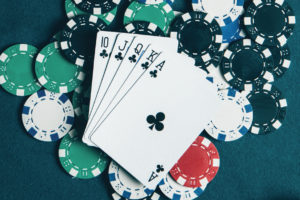By Josh Feldman
A couple of days ago, I talked on Zoom with some actuary friends for the first time since the pandemic started; we hoped to cheer each other up with a distracting story or two. Fortunately, one person in our group told a tale that did exactly that. Our friend—let’s call him Swatch—said that before the pandemic he originally planned to use his recent exam raise to buy primo St. Louis Blues season tickets. Alas, with no more games in front of spectators in the near future, instead of sitting on his refunded ticket deposit, Swatch decided to invest in a McMansion instead.
Of course all of us asked about Swatch’s new digs, and while none of could have cared less about the number of bathrooms or the size of the master suite, one aspect of the house definitely caught our eye: Swatch decided to turn his basement into a regulation-size basketball court. We couldn’t believe the pictures. It was a sight to behold!
Our friend Big T then asked Swatch the question we all were afraid to ask: How much basketball do you play? If one has the commitment to renovate a basement into a court, we all assumed that Swatch had a secret basketball addiction that none of us knew about. Hence, Swatch stunned us all when he said he hasn’t touched a basketball since 7th grade. Chef, channeling his Al Bundy “I scored four touchdowns in one game” speech, took all of this basketball talk as an opportunity to mention his greatest basketball achievement, when he hit 90 out of 100 free throws during his senior year in high school.
Swatch, always up for the challenge, said that sounds doable, and bet the group that he could hit 90 out of 100 free throws after a couple months of practice. After some trash-talking, the free throw challenge came about. On a specific day in December, Swatch has to hit 90 out of 100 free throws. According to the rules of the bet, Swatch can have as many attempts as he wanted, but he has to announce before each set of 100 shots when the set would begin. This way, Swatch couldn’t just take 5,000 free throws and see afterwards if there was a string of 100 shots where he made 90 of them afterwards. In effect, Swatch could start over on a set whenever he wanted, but once he made the decision to start over, that decision was irrevocable.
As someone who didn’t take a side in the wager at hand, Big T came up to me afterwards and asked if I thought Swatch would conquer the free throw challenge. I had no idea! Big T then said with a lot of practice, he thought that Swatch could realistically become an 80% free throw shooter. I told Big T that even with this information, it would be difficult to figure out if Swatch would prove victorious. Then again, it wouldn’t surprise me if my puzzle-solving readers could come up with the answer!
If Swatch is an 80% free throw shooter, and assuming each free throw is random and independent, what is the probability of Swatch making at least 90 out of his first 100 free throws taken?
Assume that Swatch can reasonably shoot 5,000 free throws on the day of the challenge. What is the probability somewhere in that 5,000 shots there is a string of 100 free throws where Swatch does indeed make 90 or more of them?
Assume Swatch is in the middle of an attempt and makes 77 of his first 87 free throws. Should Swatch attempt to hit 13 free throws in a row and win the challenge, or does he have a better probability in starting the set over and trying to hit 90 of the next 100 attempts?
Assuming that Swatch always optimally decides when to start a set over, what is the probability that Swatch wins the challenge given the agreed upon rules, given that he attempts 5,000 free throws on the day of the challenge?
Solutions to Chaucer’s Puzzles
The Steward’s Puzzle
I accepted a 7/1 split to Miller & Weaver respectively and I also accepted a 5/3 split.
Solution. Most solvers said that the amount consumed by the Miller & Weaver should be subtracted from their contribution leading to a 7/1 split. One solver suggested that the split should be 5/3 based on the proportion of each person’s contribution. (Some solvers gave no justification for their answers.) This seemingly simple problem leaves out a few important points. What were the goals of the hosts? Did they have any prior understandings? What was the total amount consumed? I think an argument could even be made for a 4/4 split.
The Miller’s Puzzle
There are four solutions:
2_78_156_39_4
4_39_156_78_2
3_58_174_29_6
6_29_174_58_3
The first requires the fewest moves. Solution. More than one solver (said) they listed and inspected all 9! = 362,880 permutations of the 9 digits 1 to 9. I am fortunate they didn’t send them to me to check. For a slightly less intensive approach, label the positions A_BC_DEF_GH_I. Then we can make the following observations. 1) F must be even. 2) Either D or E is 1. 3) None of A, C, H, or I can be 5. 4) If any of A, C, H, or I is odd it is equal to either 3, 7, or 9.and 5) D is less than 8.
Case I. E=1. There are 21 possibilities for DEF. They are 214, 216, 218, 312, 314, 316, …, 718. To be a solution, one of the 21 must be divisible by two of 2,4,6,8,3,7,9 that are not already D or F and the digits of the two dividends must not duplicate each other or digits already used. Some shortcuts can be used in checking. For example, it is easy to tell if DEF is divisible by 3 or 9 by adding the digits, etc. Checking indicates no solutions in this case.
Case II. D=1 and E=5. There are only 4 possibilities for DEF 152, 154, 156, 158. Using the analysis from Case I, we find that 156/2=78 and 156/4=39. This gives two solutions, 2_78_156_39_4 and its reverse. (By reverse, I mean 4_39_156_78_2.) There are no other solutions in this case.
Case III. D=1 and B=5. Since A=DEF/BC<198/52=3.81. That implies A=3 and BC is one of 52, 54, 56, 58. Their products are 156, 162, 168, and 174 respectively. Using analysis similar to the above, 156 and 168 can be dismissed immediately. Although 162/9=18 doesn’t work, 174/6 =29 does, giving two more solutions 3_58_174_29_6 and its reverse.
(Thanks to Matt Stephenson for the idea that simplified the above derivation.)
Of the four solutions, 2_78_156_39_4 matches the initial position in 4 places, thus it requires moving only 5 bags. The other 3 solutions each match only at 2 places requiring 7 moves.
The Pardoner’s Puzzle
I said there was more than one solution. In fact, 11 different solutions were submitted and by using pieces of those, eight more could be constructed, for a total of 19. I don’t know if 19 is the maximum. Submitted solutions were two types: those that end at (2,2) and those that end at (1,1). John Snyder seems to have shown that there are only 7 ending at (2,2). One of each type is exhibited.
Solvers
Correction: Robert Bartholomew should be added to the January/February 2020 Solvers list. So he gets two credits this month. Robert Bartholomew, Bob Byrne, Bob Conger, Andrew Dean, David Engelmayer, Bill Feldman, Nick Franceschine, Yan Fridman, Rui Guo, Clive Keatinge, David Lovit, Stephen O’Brian, Donald Onnen, David Promislow, Noam Segal, Daniel Sherman, John Snyder, Mark Spong, Al Spooner, Matt Stephenson, Ronald Stokes, John Vrysen, Eun Soo L. Yau





